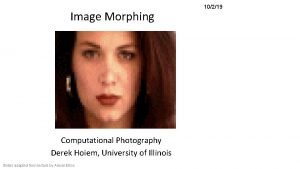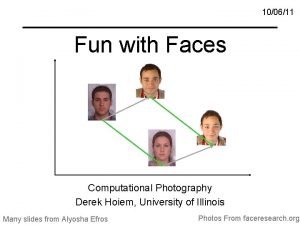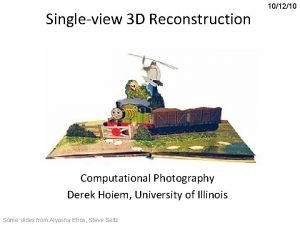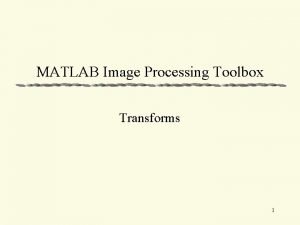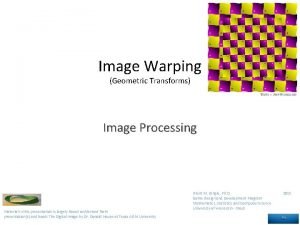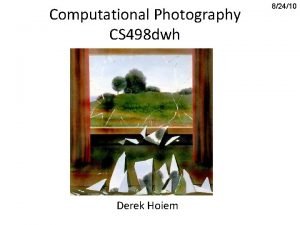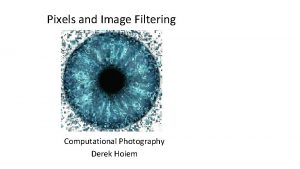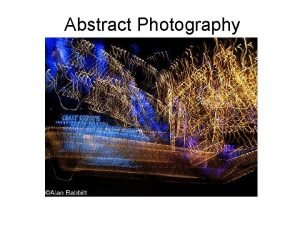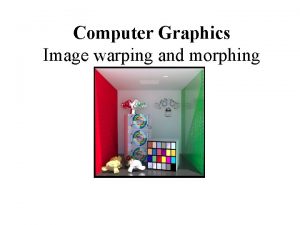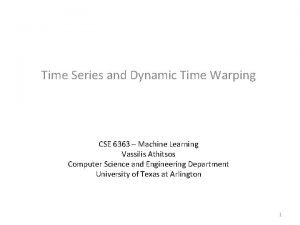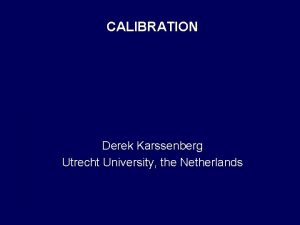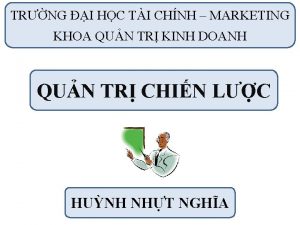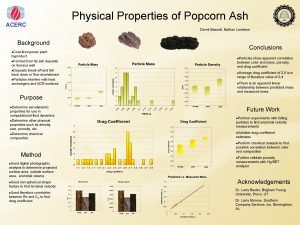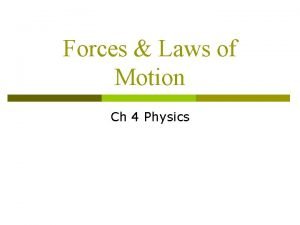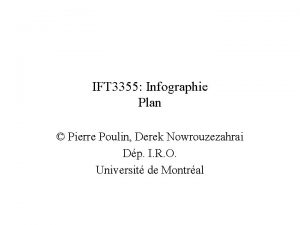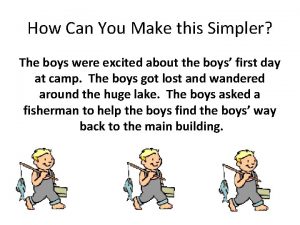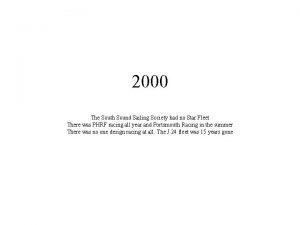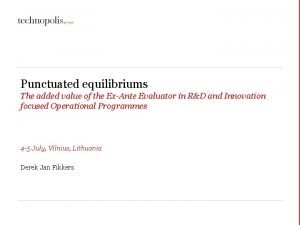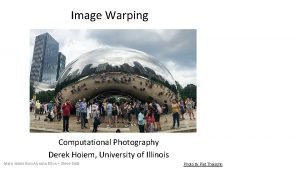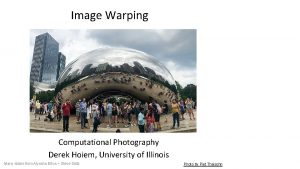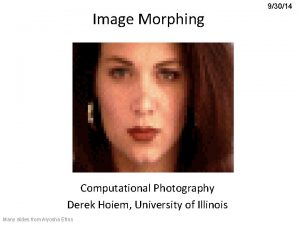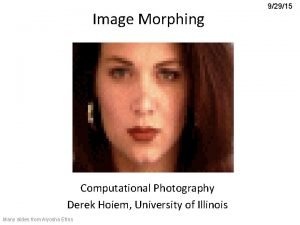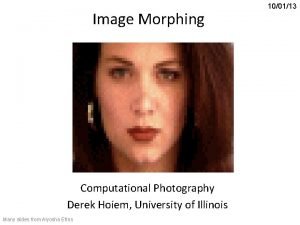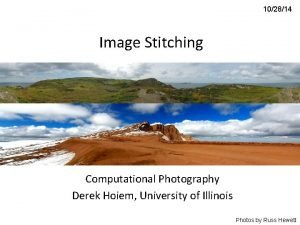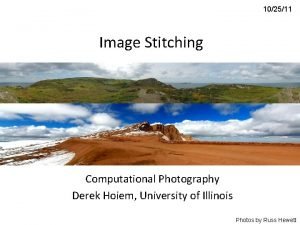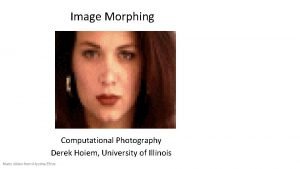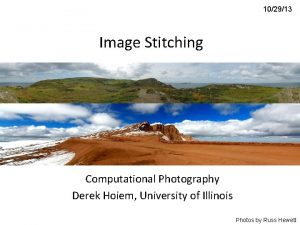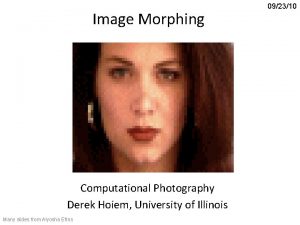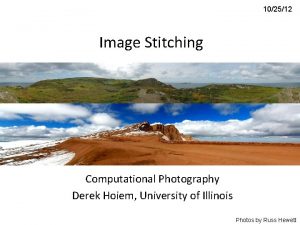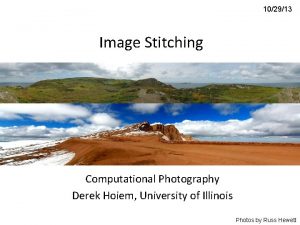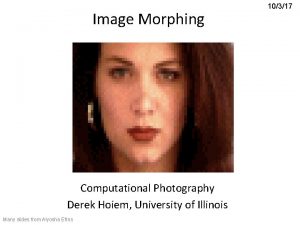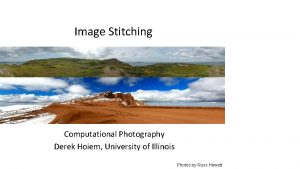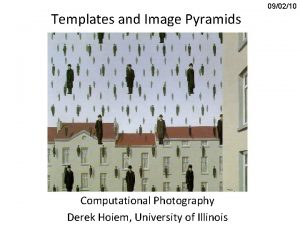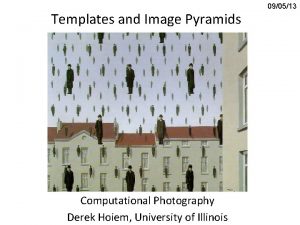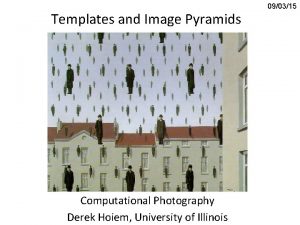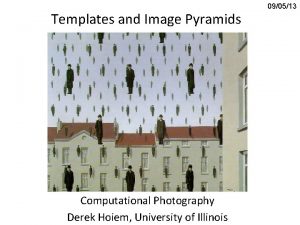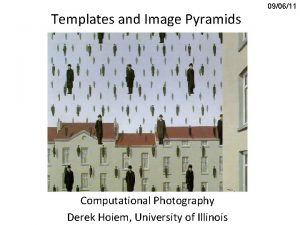092613 Image Warping Computational Photography Derek Hoiem University













































- Slides: 45

09/26/13 Image Warping Computational Photography Derek Hoiem, University of Illinois Many slides from Alyosha Efros + Steve Seitz Photo by Sean Carroll

Last class: gradient-domain processing for blending A good blend should preserve gradients of source region without changing the background

Last class: Gradient-domain editing Many image processing applications can be thought of as trying to manipulate gradients or intensities: – Contrast enhancement – Denoising – Poisson blending – HDR to RGB – Color to Gray – Recoloring – Texture transfer See Perez et al. 2003 and Gradient. Shop for many examples

Gradient-domain processing Saliency-based Sharpening http: //www. gradientshop. com

Gradient-domain processing Non-photorealistic rendering http: //www. gradientshop. com

Take-home questions 1) I am trying to blend this bear into this pool. What problems will I have if I use: a) Alpha compositing with feathering b) Laplacian pyramid blending c) Poisson editing? Lap. Pyramid Poisson Editing

Take-home questions 2) How would you make a sharpening filter using gradient domain processing? What are the constraints on the gradients and the intensities?

Next two classes • Today – Global coordinate transformations – Image alignment • Tuesday – Interpolation and texture mapping – Meshes and triangulation – Shape morphing

Photo stitching: projective alignment Find corresponding points in two images Solve for transformation that aligns the images

Morphing Blend from one object to other with a series of local transformations

Capturing light fields Estimate light via projection from spherical surface onto image

Image Transformations image filtering: change range of image g(x) = T(f(x)) f f T x x image warping: change domain of image g(x) = f(T(x)) f f T x x

Image Transformations image filtering: change range of image g(x) = T(f(x)) f g T image warping: change domain of image g(x) = f(T(x)) f T g

Parametric (global) warping T p = (x, y) p’ = (x’, y’) Transformation T is a coordinate-changing machine: p’ = T(p) What does it mean that T is global? – Is the same for any point p – can be described by just a few numbers (parameters) For linear transformations, we can represent T as a matrix p’ = Mp

Parametric (global) warping Examples of parametric warps: translation affine rotation perspective aspect cylindrical

Scaling • Scaling a coordinate means multiplying each of its components by a scalar • Uniform scaling means this scalar is the same for all components: 2

Scaling • Non-uniform scaling: different scalars per component: X 2, Y 0. 5

Scaling • Scaling operation: • Or, in matrix form: scaling matrix S What is the transformation from (x’, y’) to (x, y)?

2 -D Rotation (x’, y’) (x, y) x’ = x cos( ) - y sin( ) y’ = x sin( ) + y cos( )

2 -D Rotation (x’, y’) (x, y) f Polar coordinates… x = r cos (f) y = r sin (f) x’ = r cos (f + ) y’ = r sin (f + ) Trig Identity… x’ = r cos(f) cos( ) – r sin(f) sin( ) y’ = r sin(f) cos( ) + r cos(f) sin( ) Substitute… x’ = x cos( ) - y sin( ) y’ = x sin( ) + y cos( )

2 -D Rotation This is easy to capture in matrix form: R Even though sin( ) and cos( ) are nonlinear functions of , – x’ is a linear combination of x and y – y’ is a linear combination of x and y What is the inverse transformation? – Rotation by – – For rotation matrices

2 x 2 Matrices What types of transformations can be represented with a 2 x 2 matrix? 2 D Identity? 2 D Scale around (0, 0)?

2 x 2 Matrices What types of transformations can be represented with a 2 x 2 matrix? 2 D Rotate around (0, 0)? 2 D Shear?

2 x 2 Matrices What types of transformations can be represented with a 2 x 2 matrix? 2 D Mirror about Y axis? 2 D Mirror over (0, 0)?

2 x 2 Matrices What types of transformations can be represented with a 2 x 2 matrix? 2 D Translation? NO! Only linear 2 D transformations can be represented with a 2 x 2 matrix

All 2 D Linear Transformations • Linear transformations are combinations of … – – • Scale, Rotation, Shear, and Mirror Properties of linear transformations: – – – Origin maps to origin Lines map to lines Parallel lines remain parallel Ratios are preserved Closed under composition

Homogeneous Coordinates Q: How can we represent translation in matrix form?

Homogeneous Coordinates Homogeneous coordinates • represent coordinates in 2 dimensions with a 3 -vector

Homogeneous Coordinates 2 D Points Homogeneous Coordinates • Append 1 to every 2 D point: (x y) (x y 1) Homogeneous coordinates 2 D Points • Divide by third coordinate (x y w) (x/w y/w) Special properties • Scale invariant: (x y w) = k * (x y w) • (x, y, 0) represents a point at infinity • (0, 0, 0) is not allowed y Scale Invariance 2 (2, 1, 1) 1 1 2 x or (4, 2, 2) or (6, 3, 3)

Homogeneous Coordinates Q: How can we represent translation in matrix form? A: Using the rightmost column:

Translation Example Homogeneous Coordinates tx = 2 ty = 1

Basic 2 D transformations as 3 x 3 matrices Translate Scale Rotate Shear

Matrix Composition Transformations can be combined by matrix multiplication p’ = T(tx, ty) R(Q) S(sx, sy) Does the order of multiplication matter? p

Affine Transformations Affine transformations are combinations of • Linear transformations, and • Translations Properties of affine transformations: • • • Origin does not necessarily map to origin Lines map to lines Parallel lines remain parallel Ratios are preserved Closed under composition

Projective Transformations Projective transformations are combos of • Affine transformations, and • Projective warps Properties of projective transformations: • • Origin does not necessarily map to origin Lines map to lines Parallel lines do not necessarily remain parallel Ratios are not preserved Closed under composition Models change of basis Projective matrix is defined up to a scale (8 DOF)

2 D image transformations These transformations are a nested set of groups • Closed under composition and inverse is a member

Recovering Transformations ? T(x, y) y’ y x f(x, y) x’ g(x’, y’) • What if we know f and g and want to recover the transform T? – willing to let user provide correspondences • How many do we need?

Translation: # correspondences? ? T(x, y) y’ y x x’ • How many Degrees of Freedom? • How many correspondences needed for translation? • What is the transformation matrix?

Euclidian: # correspondences? ? T(x, y) y’ y x x’ • How many DOF? • How many correspondences needed for translation+rotation?

Affine: # correspondences? ? T(x, y) y’ y x x’ • How many DOF? • How many correspondences needed for affine?

Affine transformation estimation • Math • Matlab demo

Projective: # correspondences? ? T(x, y) y’ y x x’ • How many DOF? • How many correspondences needed for projective?

9/26/13 Take-home Question 1) Suppose we have two triangles: ABC and A’B’C’. What transformation will map A to A’, B to B’, and C to C’? How can we get the parameters? B’ B ? T(x, y) A Source C C’ A’ Destination

9/26/2013 Take-home Question 2) Show that distance ratios along a line are preserved under 2 d linear transformations. o (x 3, y 3) o o p 1=(x 1, y 1) (x 2, y 2) p‘ 1= (x o ’ 1 , y ’ 1 ) o (x ’ 2 , y ’ 2 ) (x o ’ 3 , y ’ 3 ) Hint: Write down x 2 in terms of x 1 and x 3, given that the three points are co-linear

Next class: texture mapping and morphing
 Derek hoiem
Derek hoiem Derek hoiem
Derek hoiem Derek hoiem
Derek hoiem Image warping matlab
Image warping matlab Affine image warping
Affine image warping Computational photography uiuc
Computational photography uiuc Computational photography uiuc
Computational photography uiuc Is abstract photography same as conceptual photography
Is abstract photography same as conceptual photography Warping in computer graphics
Warping in computer graphics Warping in computer graphics
Warping in computer graphics Point out
Point out Eamonn keogh
Eamonn keogh Morphing
Morphing Eamonn keogh
Eamonn keogh What does this sign mean
What does this sign mean Introduction to dsp
Introduction to dsp Dynamic time warping
Dynamic time warping Digital photography with flash and no-flash image pairs
Digital photography with flash and no-flash image pairs Codeopinion github
Codeopinion github 3825 greenspring avenue
3825 greenspring avenue Derek england
Derek england Derek paiz
Derek paiz Grandfather poem derek mahon
Grandfather poem derek mahon Derek jeter childhood
Derek jeter childhood Fay moston
Fay moston Derek comartin
Derek comartin Derek karssenberg
Derek karssenberg Ma trận ie
Ma trận ie Barbara stringer
Barbara stringer Ap literature frq
Ap literature frq Physical properties of popcorn
Physical properties of popcorn Derek farnsworth
Derek farnsworth Derek donahue
Derek donahue A student attaches a rope to a 20 kg box of books
A student attaches a rope to a 20 kg box of books Derek wasnock
Derek wasnock Takoyaki karamunsing
Takoyaki karamunsing Derek nowrouzezahrai
Derek nowrouzezahrai Deric peacock
Deric peacock Did you see derek and her or she
Did you see derek and her or she Derek grooms
Derek grooms Derek brewin
Derek brewin South sound sailing society
South sound sailing society Advanced ops idaho
Advanced ops idaho Derek jeter diet
Derek jeter diet Derek jan fikkers
Derek jan fikkers Dr. derek jones
Dr. derek jones
